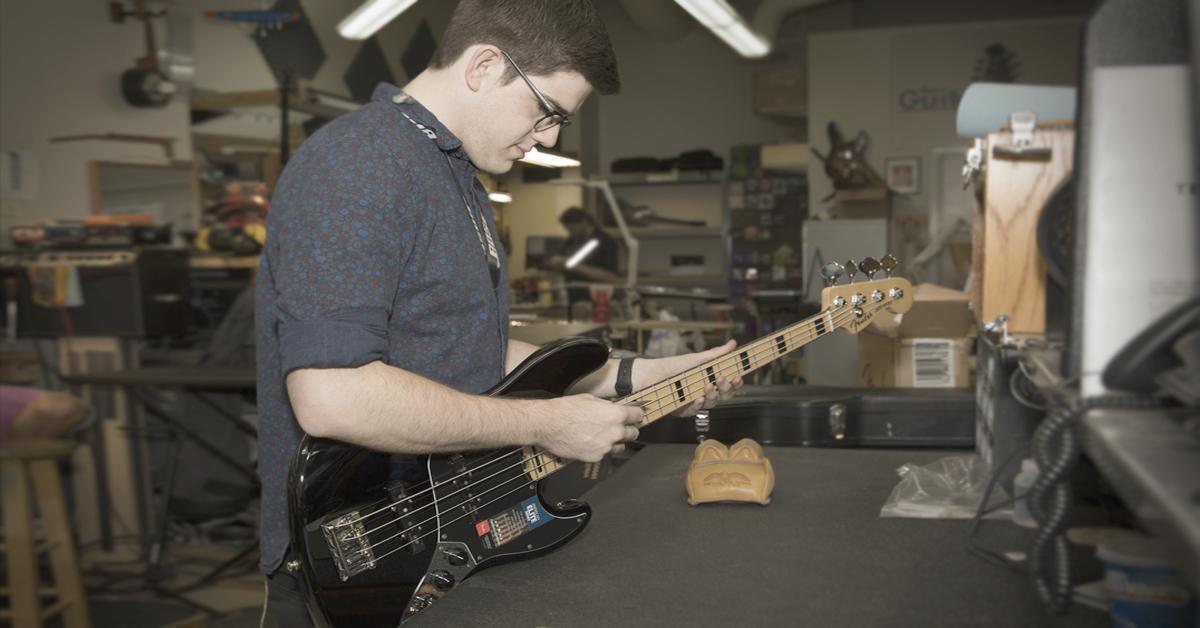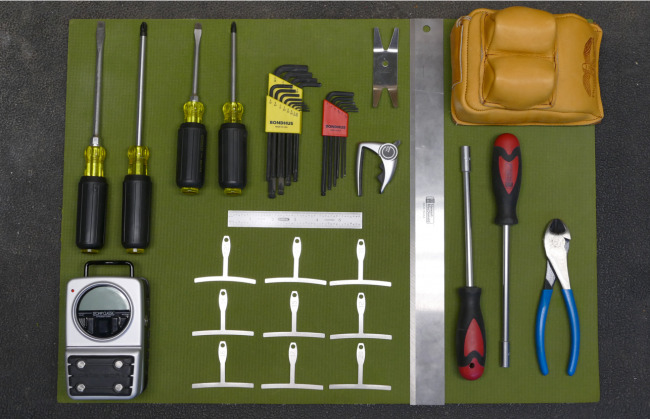How To Set Up A Bass

To set upward your bass guitar, you have to think big: large sound, big tone, big volume. This also means big sound waves and big string vibrations. With this in heed, y'all have to approach your setup in a style that compensates for all of this and your playing manner. Are you a jazz role player with a low-cal touch and lightning-fast licks, or do you lot jackhammer funk riffs with thumb slaps and finger pops? Here are a few tips and tricks that should get you lot in the right management to dialing in the perfect bass guitar setup.
Tools Y'all'll Demand:
- Phillips/large flathead screwdriver or spanner wrench
- Allen wrenches or socket wrench
- 6″ ruler graduated in 1/32″ and ane/64″ increments (0.5mm increments)
- Electronic Tuner
- Neck residual to secure the guitar
- Capo (optional)
- A good set of optics and ears

A good tool kit is quite helpful for maintaining your instrument. We recommend the Musician's Tool Kit from Ernie Ball.
Adjusting the Truss Rod
The showtime step to dialing in your bass guitar's setup is tuning your bass to pitch and setting your neck to the proper relief. This refers to the amount your cervix bows abroad from the strings. If your strings are onetime, not staying in tune, or take lost their mojo, you'll desire to install a new set get-go. (I know, we bass players have to beat out out more money than the other guys in our band, merely dig deep in your pockets and get it out of the style at present.)
Step One: Checking your neck relief
- Install a capo on the first fret. (If you don't have a capo, your finger will piece of work simply fine.)
- Fret the everyman cord (in pitch) where the neck joins the trunk.
What you've done is create a perfectly straight line across the length of the fretboard. Take a look at the gap betwixt the peak of the 7th fret and the bottom of the string. If you have a feeler approximate, you'll want to measure that and make a note of it. It'due south actually a adept affair to take a slight gap in that location, because a perfectly straight cervix will cause a lot of buzzing issues. Your strings must accept plenty clearance to do their vibrational pattern. Motion-picture show yourself dropping a pebble into a pond. Look… this is a bass. Picture yourself dropping a boulder into a pond. Those waves that emanate from the splash are what your bass strings are doing when you play, and yous accept to get the frets out of the fashion. Some target relief measurements are anywhere from 0.008″ to 0.014″.

Stride Two: Adjusting your neck relief
- If y'all have no relief or the cervix is bowed toward the strings (backbow), you'll desire to plow your truss rod counterclockwise. Yous'll recognize this right abroad considering the straight line you created in step one will cause the bottom of the cord to rest against the top of the 7th fret. This volition cause excess fret buzz on open strings and in the middle of the fretboard.
- If you have too much relief, you'll desire to tighten your truss rod past turning information technology clockwise. Besides much bow away from the strings volition cause unnecessarily high activeness, intonation problems, and buzzing toward the end of the fretboard.
Pro Tips:
- Simply brand about a ¼-turn adjustment at a fourth dimension.
- Always melody your guitar back to pitch before checking whatsoever measurements.
- Practise not overtighten your truss rod or make any adjustments you lot aren't comfy with.
- If your truss rod reaches the end of its travel before the proper adjustment is made, take your guitar to a reputable luthier or technician.
Setting the Activity
Once your truss rod is properly prepare, y'all'll want to heighten or lower the distance your string has to travel to the frets. This is what is referred to as action. Exercise yous recall the boulder that nosotros tossed into the pond? Well, that boulder is your finger, pick, pollex, or whatever yous're using to beat up your strings. Proper bass guitar action is completely subjective and will depend more often than not on your playing style. Retrieve, "every activity has an equal and reverse reaction." (I think John Entwistle said that.) If yous play a lot of slap bass or take a actually potent pick assault, y'all'll want to compensate that by raising your action and allowing the cord plenty room to circulate.
If you're more laid back in your approach to the bottom end or have a lighter touch with your fingers, you can probable become away with a lower activeness that's going to result in easier playability. A good bass setup is all almost compromise, and as a guitar technician, you always have to detect the best balance between playability and the most amount of fret fizz that you're willing to tolerate. Some common action measurements on a bass guitar are around 5/64″ upwardly to about 7/64″.
Footstep One: Measuring the activeness
- Some luthiers prefer to install a capo at the first fret to accept nut summit out of the equation. If you don't have one, don't permit that terminate you lot.
- With your ruler, measure the distance from the top of the 12thursday fret to the bottom of your lowest string. We typically use minor increments in social club to be as accurate as possible. A ruler that'due south graduated in 64ths of an inch is a great tool to keep in your gig bag or instance.
Y'all'll desire to play the bass and make up one's mind what activeness adjustments need to be fabricated. If information technology feels and sounds great, don't mess with a good affair. If you find that your bass is clunky to play and your fingers experience like they've been run over past a truck at the end of a gig, you'll probably want a lower action.
Fret fizz and loss of sustain are typically symptoms of an action that is too low. If your bass just isn't handling the beating yous're dishing out or you feel a loss of clarity in your notes, a higher action is probably going to be your adjacent course of action.
Step Two: Raising and lowering your action
- Raise or lower your saddle or the bass side of the bridge almost a quarter of a turn.
- Retune the bass to pitch, and take another measurement to go an thought of how much farther upward or downward you'll need to go.
- Make more than adjustments if you demand to and ever recall to retune the instrument before y'all take into business relationship any measurements.
- Y'all'll desire to echo these steps for the rest of your strings and the treble side of the bridge. A good rule of thumb is that you can get abroad with well-nigh 1/64 of an inch lower action on the highest-pitched string than what you've ready your lowest pitched string to. This is considering the smaller the string gauge, the tighter the vibrational pattern. (Keep this in mind the next time your guitar player whines about how high their action is, then calmly and rationally explain why they take it and so much easier than we bass players.)

Measuring and checking the action.
Pro Tips:
- The lower your activity, the more than your bass will buzz.
- Fret fizz will oftentimes non translate through an amplifier. If fret fizz is a deal breaker for you, exist sure y'all're checking to see if it's actually going to be heard through your bass rig.
- Don't set up your bass without getting a skilful idea of what it's going to audio similar when information technology's plugged in.
- Your ruler is your best friend. A good guitar technician will measure activity all over the fretboard to have into account the big moving picture. After all, we don't just play in one spot.
- Measure your activeness at the 3rd and 17th fret also.
- Your fretboard has a radius, and you'll want your string height to follow that radius. If you have a 2-postal service bridge, you shouldn't take to worry virtually it because your saddles will be pre-slotted. If you are adjusting individual saddles, you'll need to maintain that radius by cascading downwardly your measurements from the lowest-pitched cord to highest or making the proper adjustments confronting a radius gauge.
These are the basics of a bass guitar setup. A practiced setup is non all about measurements. It's most the fashion your instrument sounds and plays and is a very personal thing that varies from one actor to the next. But these are some good references to get yous on the right track to dialing in the perfect bass setup for you.
At present that you've mastered adjusting your bass guitar's truss rod and activeness, you'll want to make sure that y'all dial in your intonation so that your instrument is playing in tune.
If yous need to prepare upwardly the intonation on your electric guitar, cheque out this article: "How to Set Your Electrical Guitar'southward Intonation".
We promise this has helped you lot acquire a trivial more well-nigh setting up your bass. As always, feel free to contact our SweetCare squad for any specific questions y'all may take, or visit our Knowledge Base of operations, which has over xx,000 articles that may help you resolve an issue apace!
Source: https://www.sweetwater.com/insync/how-to-set-up-a-bass/

0 Response to "How To Set Up A Bass"
Post a Comment